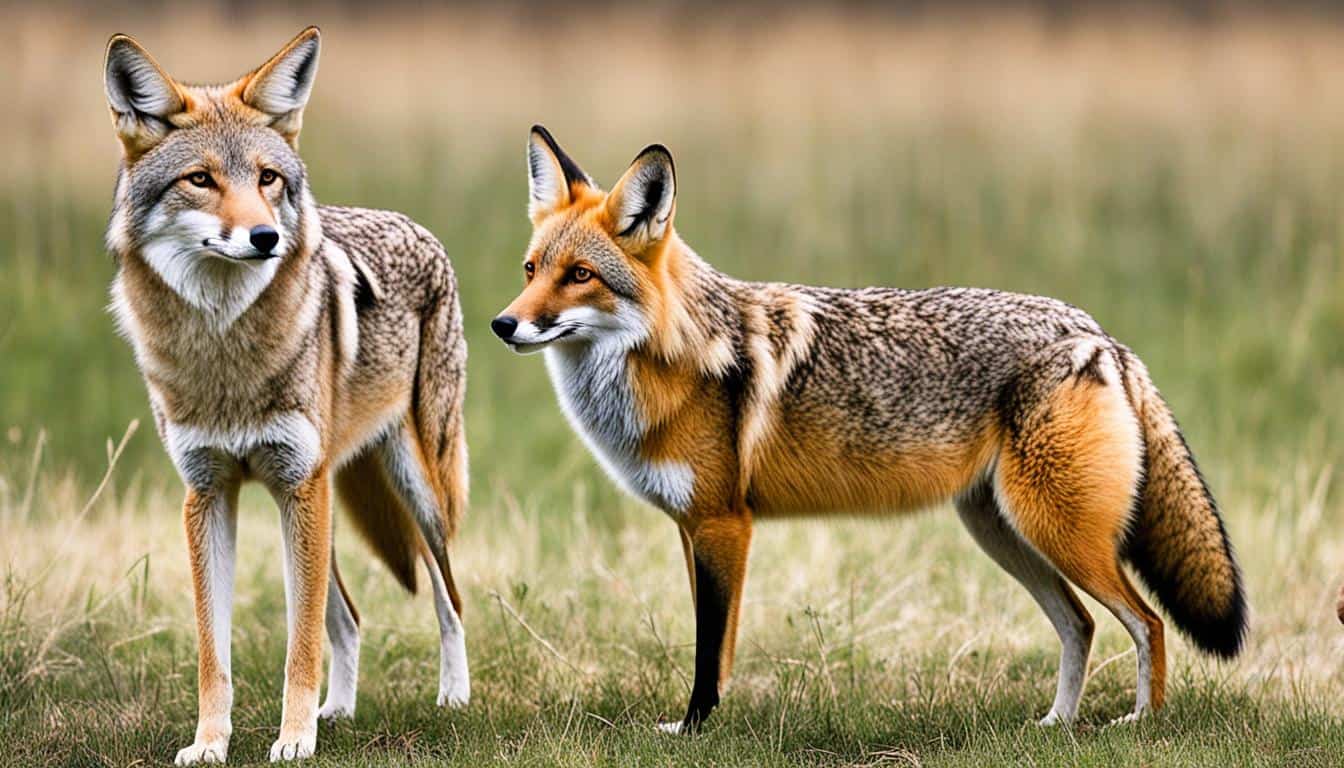The red fox and the gray fox live in different places. The red fox is found in many spots, even cities. The gray fox prefers forests and can climb trees.
Coyotes are usually bigger, especially in the east US. They avoid people and cities. These differences help us tell coyotes and foxes apart out in nature.
Coyote vs Fox: Physical Characteristics
Looking at the physical features of coyotes and foxes is very interesting. Knowing these differences helps in identifying them in the wild. This knowledge is key when you see these animals.
Size and Weight
Coyotes are usually bigger than foxes. They can weigh from 10 to 35 pounds and reach 18 to 23 inches in height. Foxes, on the other hand, are smaller. This size difference is a big clue when looking at a coyote or fox.
Fur Color and Patterns
Coyotes have fur that is a mix of brown, gray, and tan with black strands. Their tails are bushy and have black tips. In comparison, foxes have bright, unique color patterns. These distinct fur colors help a lot when trying to tell them apart.
Body Structure
Coyotes have a sleek body, a slim snout, lesser paws, and bigger ears. Foxes, with their small size and pointed snouts, look very different. Observing these details is essential in correctly recognizing a coyote or fox.
| Characteristics | Coyote | Fox |
|---|---|---|
| Weight | 10-35 pounds | Less than Coyotes |
| Height | 18-23 inches | Shorter than Coyotes |
| Fur Color | Brown, gray, tan with black strands | Vibrant, distinct patterns |
| Snout | Narrow | More pointed |
| Ears | Larger | Smaller |
Habitats of Coyotes and Foxes
Learning about where coyotes and foxes live helps us understand them better. They are part of the Canidae family. These animals can live in cities and the countryside. They show great flexibility in their living spaces.
Urban vs Rural Settings
Red foxes like to live in cities due to lots of food and places to hide. Gray foxes, on the other hand, prefer the quiet of forests. Their ability to climb trees is a big plus in forests.
Coyotes can be found in both city and country areas. They are careful and avoid getting too close to people. This allows them to make use of city and wild areas while keeping away from direct contact with humans.
Natural Preferences
In cities, red foxes do well, showing how adaptable they are. Gray foxes enjoy the peacefulness of wooded areas more. Coyotes, with their savvy ways, live in many places, from city outskirts to remote wilderness.
Even though they are good at adapting, coyotes and foxes typically stay away from very busy human areas. This shows they are shy animals. Their choices in where to live show how they have changed their habitats to fit in as urban areas grow.
Behavioral Traits: Coyote vs Fox
Studying the actions of coyotes and foxes gives us deep insight into their lives. Both animals have social behaviors that show how they fit in different places.
Hunting Styles
When it comes to hunting, coyotes and foxes do things differently based on what makes them special. Coyotes often hunt as a team, making it easier to catch big prey using their strength and numbers. This teamwork in hunting shows their strong coyote and fox behavior in the wild.
Foxes, however, usually hunt alone. They are quick and clever, catching small animals like mice and birds. For example, the red fox surprises its meal with a sudden jump. This solitary style contrasts with the coyotes but is just as effective.
Social Structures
The way coyotes and foxes organize themselves gives us clues about their lives. Coyotes live in family groups with a mom and dad, the pups, and sometimes close relatives. They support each other in defending their home and finding food, showing strong family coyote and fox behavior.
Foxes, on the flip side, tend to be more independent. Typically, red foxes live in small groups, while gray foxes prefer to live alone. The gray fox may become more active with others when it’s time to mate. This biology shows they can adjust their social ways for different needs, which is interesting and key to their survival.
How to Identify a Coyote
Knowing how to spot a coyote helps you distinguish between coyotes and foxes in the wild. Coyotes look different than foxes due to their unique features. Learning these traits makes identification easier.
Distinctive Features
Coyotes are built heavy with long legs and a short, dark-tipped tail. This tail often hangs down as they move. They usually range in color from gray to cinnamon gray. Their size and fur texture are key factors in spotting them.
Common Misidentifications
Mistaking coyotes for domestic dogs or foxes is a big challenge. Remember, coyotes are bigger and their fur is different from these animals. Using clear identification methods will help avoid such mistakes.
How to Identify a Fox
Foxes are interesting animals with features that set them apart. This part will guide you in exploring the fox identification guide. It focuses on the differences in fox species for better recognition.
Varieties of Foxes
Knowing the fox types is key to spotting them correctly. The red fox and the gray fox are the main ones you might see. Each has special traits that distinguish it from others.
Key Identification Tips
| Species | Key Features |
|---|---|
| Red Fox | Rusty red back, black ears, black lower legs (like dark stockings), and a long tail with a white tip. |
| Gray Fox | Grizzly gray back, no black stockings, black stripe running the length of the tail, and a black tail tip. |
Noting the differences in fox species is vital with a fox identification guide. By looking for their unique features, you can tell the species apart.
Telling Coyote and Fox Apart
Seeing a wild canid and knowing if it’s a coyote or a fox is important. This tells us a lot about how they act and their living habits. One easy way to tell is by size. Coyotes are much bigger, weighing 10 to 35 pounds. They stand 18 to 23 inches tall at the shoulder. Foxes, on the other hand, are quite smaller.

Fur color can also help with identification. Coyotes have gray, brown, and tan fur that makes them blend in well. Foxes stand out with their bold colors. For example, a red fox has bright rusty red fur. It also has black on its ears and legs. A gray fox has a gray coat and a black-striped tail.
Looking at how they behave gives hints too. Coyotes are more like wolves, with their strong bodies and long legs. They stay away from places with lots of people, preferring open spaces for hunting. Foxes are smaller and more agile. They are comfortable living in many places, even cities.
| Characteristics | Coyote | Fox |
|---|---|---|
| Size | 10-35 pounds, 18-23 inches at the shoulder | Smaller, generally under 15 pounds |
| Fur Coloration | Gray to cinnamon gray, with black strands | Varied—red foxes have rusty red fur, gray foxes have grizzled gray fur |
| Behavior | Avoids developed areas, prefers open habitats | Adaptable to urban and suburban areas |
Recognizing these details is important for wildlife fans and scientists alike. Knowing a coyote from a fox helps us learn about their roles in nature. This knowledge deepens our connection with the environment.
What are the differences between a coyote and a fox?
It’s key to know how to tell a coyote and a fox apart for animal lovers and experts. They differ in size, tails, and ears. Learning about these features helps us see what makes each animal special.
Size Comparison
Coyotes are bigger than foxes. A typical coyote weighs 10 to 35 pounds and is 18 to 23 inches tall. Foxes, on the other hand, are smaller. They usually weigh 5 to 15 pounds and stand about 15 inches tall. This big size difference is a major clue for telling them apart.
Tail Characteristics
The look of their tails also helps in their identification. Coyotes have bushy tails with black tips that hang down. Contrastingly, foxes’ tails are lighter and have special marks. For instance, red foxes have white tips on their tails. Tails are important for telling these animals apart.
Ear Size and Shape
Looking at their ears gives clues too. Coyotes have big, pointed ears compared to foxes. This isn’t just looks; it’s about how they live. Paying attention to their ears can really help in knowing who is who.
| Characteristic | Coyote | Fox |
|---|---|---|
| Size | 10-35 pounds; 18-23 inches at the shoulder | 5-15 pounds; around 15 inches at the shoulder |
| Tail | Bushy with black tips, hangs down | Lighter with unique markings, white-tipped |
| Ears | Proportionally larger and pointed | Smaller and less pointed |
To truly tell a coyote from a fox, look closely at their size, tails, and ears. These details help us understand and admire these amazing animals. Make sure to look at every part from head to tail for a correct guess.
Ecological Roles of Coyotes and Foxes
Coyotes and foxes play big parts in nature, helping keep things in balance. They do this through their unique actions in the environment. By looking at what both coyotes and foxes do, we can see how vital they are for biodiversity.
Coyotes are found from Central to North America and are very good at living in different places. They eat small animals, which in turn helps plants grow. This is because there are fewer plant-eating creatures around.
Foxes do a lot to control pests and keep their areas clean, especially in towns and cities. They eat insects and small rodents and also help by cleaning up dead animals. This cleaning job is important as it stops diseases from spreading.
Coyotes and foxes each have their own special job in nature. Their unique ways of living allow them to fill different niches in the environment. Together, they help keep the ecosystems they live in healthy and stable.
Interactions with Humans
Urbanization is pushing into wildlife homes, coexisting with coyotes and foxes. These animals are adapting well to living near people. Learning how they adjust can reduce problems and make living together better.
Coyote Adaptations
Coyotes are making themselves at home in more urban places, especially in California. They can act like big dogs, blending in. Skills like hunting smaller animals and using green spaces show they can live alongside us.
Fox Behavior in Suburban Areas
Foxes, known for their red and gray types, also live near people, showing they can adapt. Red foxes find food in cities and hunt for rats. Gray foxes mostly stay near woods but might show up in quieter areas. Knowing about foxes can help avoid issues and live together peacefully.
FAQ
What are the differences between a coyote and a fox?
Coyotes are bigger and have fur that’s brown, gray, or tan. Foxes are smaller and red ones have a rusty red back, and black legs. Gray foxes’ve a grizzly grey back. Coyotes’ tails are bushier with black tips, unlike foxes’ lighter, vibrant tails.
What are the physical characteristics of a coyote compared to a fox?
Coyotes are 10 to 35 pounds and stand 18 to 23 inches tall. They have long legs, a sleek body, and big ears. Foxes are smaller and have a pointy snout. Red foxes have a white-tipped tail and gray foxes have a black-striped tail.
Where do coyotes and foxes typically live?
Coyotes live in a wide range but try to avoid heavily developed areas. Red foxes do well in cities. Gray foxes prefer forests.
How do the behaviors of coyotes and foxes differ?
Coyotes hunt in pairs or small groups and are good at hiding. Foxes usually hunt alone. How they interact with others helps them survive.
How can you identify a coyote?
Coyotes are heavier, have long legs, and a bushy tail with a black tip. They can be gray to cinnamon gray.
How can you identify a fox?
Red foxes are rusty red with black ears and legs, and a white-tipped tail. Gray foxes are grizzly grey with a black stripe on their back and a black tail tip.
How can you tell a coyote and a fox apart?
Size is one difference, with coyotes larger than foxes. They also have different tails and ears. Coyote tails are bushy with black tips. Foxes’ tails are less bushy but have bright, unique markings.
What are the size comparisons between a coyote and a fox?
Coyotes are taller, standing between 18 to 23 inches. They are much bigger than foxes, who are not heavier than 20 pounds and not taller than 18 inches.
How do the tails of coyotes and foxes differ?
Coyotes have bushy tails with black tips that hang down. Foxes’ tails are less bushy and often have white tips or other bright, unique features.
What are the differences in ear size and shape between coyotes and foxes?
Coyotes have large, pointed ears. Foxes have smaller, also pointed ears that look different from coyotes’.
What roles do coyotes and foxes play in the ecosystem?
Coyotes are important predators across Central and North America, helping balance other animal populations. Foxes, like red and gray ones, are also crucial and can live near humans well.
How do coyotes interact with human communities?
Coyotes live near humans in many places and are sometimes mistaken for domestic dogs. They are often shy, avoiding contact with people directly.
What is the behavior of foxes in suburban areas?
Red foxes do very well near people, while gray foxes prefer forests. Both types can adapt to living near humans, but they may behave differently.







